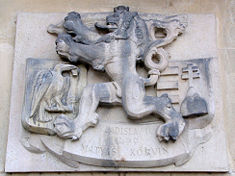
Peace of Olomouc
Encyclopedia

Hungary
Hungary , officially the Republic of Hungary , is a landlocked country in Central Europe. It is situated in the Carpathian Basin and is bordered by Slovakia to the north, Ukraine and Romania to the east, Serbia and Croatia to the south, Slovenia to the southwest and Austria to the west. The...
and King Vladislaus II of Bohemia (and Hungary, later)
Vladislaus II of Bohemia and Hungary
Vladislaus II, also known as Ladislaus Jagiellon ; was King of Bohemia from 1471 and King of Hungary from 1490 until his death in 1516...
. On July 21, 1479, the agreement was ratified during the course of festivities in Olomouc
Olomouc
Olomouc is a city in Moravia, in the east of the Czech Republic. The city is located on the Morava river and is the ecclesiastical metropolis and historical capital city of Moravia. Nowadays, it is an administrative centre of the Olomouc Region and sixth largest city in the Czech Republic...
. This treaty, overall, ratified all terms within the Treaty of Brno
Treaty of Brno (1478)
The Treaty of Brno was a draft to the Peace of Olomouc developed in March of 1478 in Brno by the envoys of Matthias Corvinus of Hungary and King Vladislaus II of Bohemia and Hungary. Corvinus accepted the accord and slightly modified it on September 20, 1478, which determined the division of...
developed in March 1478 (with slight modifications made by the King of Hungary
King of Hungary
The King of Hungary was the head of state of the Kingdom of Hungary from 1000 to 1918.The style of title "Apostolic King" was confirmed by Pope Clement XIII in 1758 and used afterwards by all the Kings of Hungary, so after this date the kings are referred to as "Apostolic King of...
on September 20, 1478). Based on the terms of the treaty, Vladislaus would cede the territories of Moravia
Moravia
Moravia is a historical region in Central Europe in the east of the Czech Republic, and one of the former Czech lands, together with Bohemia and Silesia. It takes its name from the Morava River which rises in the northwest of the region...
, Silesia
Silesia
Silesia is a historical region of Central Europe located mostly in Poland, with smaller parts also in the Czech Republic, and Germany.Silesia is rich in mineral and natural resources, and includes several important industrial areas. Silesia's largest city and historical capital is Wrocław...
, and Lusatia
Lusatia
Lusatia is a historical region in Central Europe. It stretches from the Bóbr and Kwisa rivers in the east to the Elbe valley in the west, today located within the German states of Saxony and Brandenburg as well as in the Lower Silesian and Lubusz voivodeships of western Poland...
to Cornivus. If Matthias perished, then Vladislaus was permitted to redeem these lands for 400,000 florins
Hungarian forint
The forint is the currency of Hungary. It is divided into 100 fillér, although fillér coins are no longer in circulation. The introduction of the forint on 1 August 1946 was a crucial step of the post-WWII stabilization of the Hungarian economy, and the currency remained relatively stable until...
. Moreover, both monarchs would be permitted to utilize the title King of Bohemia. However, only Matthias was required to address the other claimant as the King of Bohemia.
Sources
- Engel, Pál (translated by Tamas Palosfalvi). The Realm of St Stephen: A History of Medieval Hungary, 895-1526. I.B. Tauris, 2005. ISBN 185043977X.

